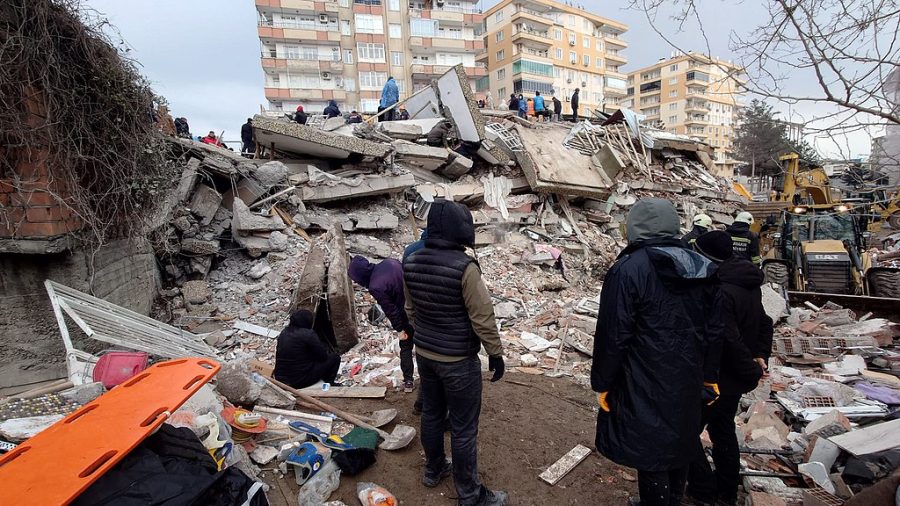Türkiye-Syria 2023 Earthquake Updates: 51,000 Dead and Rising
Search and rescue teams along with citizens view the wreckage of a collapsed building in Diyarbakır, Turkey.
February 28, 2023
On February 6, 2023, a powerful 7.8 magnitude earthquake and thousands of intense aftershocks shook the border between southeast Türkiye (formerly known as Turkey) and northwest Syria. The initial quake struck 11 miles deep near Nurdağı in Gaziantep province, putting millions of people across the region in need of aid.
Two weeks later on February 20, another earthquake with a magnitude of 6.3 hit the Hatay province of southern Türkiye.
According to United Nations International Children’s Emergency Fund (UNICEF), the death toll has surpassed 51,100 confirmed deaths as of February 26: 44,300 in Türkiye, and 6,700 in Syria. More than 26 million people are in need of assistance, including 6.5 million children.
Earthquake Stats
51,000 confirmed deaths
87,000 confirmed injuries
47,000 buildings destroyed
26 million people are in need of help
7.1 million children in need of help
5 million people in need of refuge
$84 billion lost

Earthquake Details
The epicenter of the first earthquake was Gaziantep Province, just outside the regional capital, an area home to millions of refugees, 3.5 million of which are Syrian refugees that fled their homes due to the 12-year-long violent Syrian Civil War.
In Türkiye, 10 provinces were hit by the earthquake and have declared a three-month state of emergency, including Adana, Gaziantep, Hatay, Kahramanmaras, Malatya, and Sanliurfa. In Syria, four main cities were affected, Aleppo, Latakia, Hama, and Idlib. Many of the impacted regions were already facing growing poverty and healthcare crises. Aleppo, which was one of the most affected areas, already had 4 million people relying on humanitarian aid prior to the earthquakes. This disastrous event is exacerbating issues that were already present as well as creating even more struggle for a population that has already been beaten down by war and poverty.
Other Impacts
The twin earthquakes both struck in the early morning hours of the day and hit regions that had not experienced earthquakes in more than 200 years, leaving citizens and buildings ill-prepared to deal with the disaster. As a result, the impacts have been widespread and the devastation of the earthquakes has been massive.
Research over the past 30 years has shown that it is generally the poor who tend to suffer more from disasters. Impoverished people are not only more likely to live in more dangerous areas, but also cannot afford to pay for risk-reducing measures. According to UN Secretary-General Antonio Guterres, weak governance, growing poverty, biodiversity loss, collapsing ecosystems, and unplanned rapid urbanization are all “interconnected drivers of disaster risk.”
“And when disaster strikes, weak health systems, and infrastructure leave them even more vulnerable. Decades of development gains can be wiped out in an instant,” he says.
In a region that was already vulnerable due to pervasive poverty, decades of war, immigration crises, and freezing temperatures, the earthquakes’ have exacerbated the suffering in the area.
Poverty
According to a report by The Turkish Enterprise and Business Confederation, the earthquakes caused an estimated $84 billion in losses, the equivalent of about 10% of Türkiye’s entire economy in 2022. About $70.8 billion is from the damage to homes, $10.4 billion from the loss of national income, and $2.9 billion from the loss of working days.
These estimates do not include the mass destruction of infrastructure like roads and utilities as well as ignoring the emigration of potential workers, meaning that the economic impact is likely much bigger.
Homelessness
Experts say that at least 47,000 buildings have been destroyed or damaged in by the natural disaster, rendering hundreds of thousands of people homeless and having to flee their homes in its wake. Even buildings that were not damaged have been deemed unsafe in an environment where they are in constant threat of aftershocks. Collapsed buildings have buried hundreds of children under the wreckage, suffocating them to death.
More than 5 million people across Syria are now in need of refuge while nearly a million more men, women, and children are now homeless in Türkiye. Many survivors sleep in cars, outside, or in makeshift shelters.
The freezing cold winter means that children and their families are living in sub-zero temperatures where the risk of hypothermia is extremely apparent.
Health Crisis
“In northern Syria, in particular, the threats to children from abuse were already extreme. The soaring poverty, within a warzone, now devastated by earthquakes, has created an unimaginable number of challenges, and suffering for children,” says Johan Mooij, director of World Vision’s Syria crisis response.
Diseases like Cholera and Hepatitis A run rampant due to the damage to infrastructure impacting access to sanitary food, water, and living conditions.
The mental health crisis, including rapidly rising rates of suicidal thoughts among women, children, and young adults, has worsened due to the event.
What You Can Do To Help
After first responders worked tirelessly for the first two weeks in search and rescue missions to locate survivors of the wreckage, humanitarian efforts from around the globe have shifted to recovery efforts.
The foremost concerns right now are shelter, water, power, blankets, non-food and sanitary items, and psychosocial counseling as the victims not only struggle for survival in the freezing cold but also are compounded with massive loss and trauma.
As global and local organizations work to provide shelter and aid to the victims in Türkiye and Syria. The best way to support the recovery effort is by donating to trustworthy nonprofits that are working on the front lines to provide assistance to those affected. Always remember to check an organization’s credibility on Charity Navigator or Guidestar before making a donation.
Donate To:
The United Nations International Children’s Emergency Fund, also known as UNICEF, is focusing on providing food, water, sanitation, and hygiene supplies. UNICEF is also supporting children and families in Syria. You can donate to UNICEF here.
CARE, an international organization, is working towards providing food, shelter, hygiene kits, and more. You can donate here.
Global Giving is helping fund emergency medical workers’ programs in the region. They are also shifting their focus towards assistance that boosts long-term recovery efforts. You can donate here.
The International Federation of Red Cross and Red Crescent Societies is requesting donations for its Disaster Response Emergency Fund so it can send immediate cash assistance to the region. You can donate here.
OXFAM, an international organization working to end poverty and inequality throughout the globe, has been working alongside women’s cooperatives in Türkiye to enact a short-term and long-term recovery plan. You can donate here.
The Syrian American Medical Society, a UNited-States based center for medical support in the Syrian region, has been asking for donations to allow them to continue providing medical services and emergency aid to those who need it. At least one of their hospitals was damaged in the earthquakes. You can donate here.
Save the Children is an organization focused on helping provide children with food, shelter, and warm clothing. They are accepting donations for their Children’s Emergency Fund here. You can donate here.
The Union of Medical Care and Relief Organizations, which have been providing aid and relief to Syria and Türkiye since 2012, are collecting money to provide medical relief and healthcare services to the affected people. You can donate here.






































Marco • Feb 28, 2023 at 3:53 pm
Very sad what has happened.